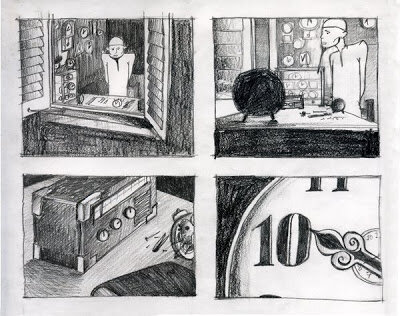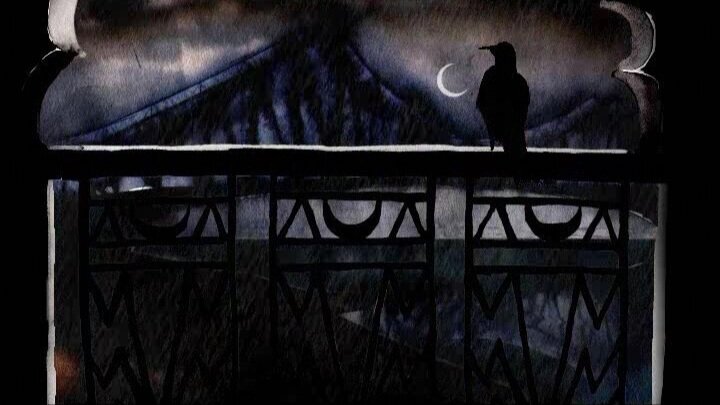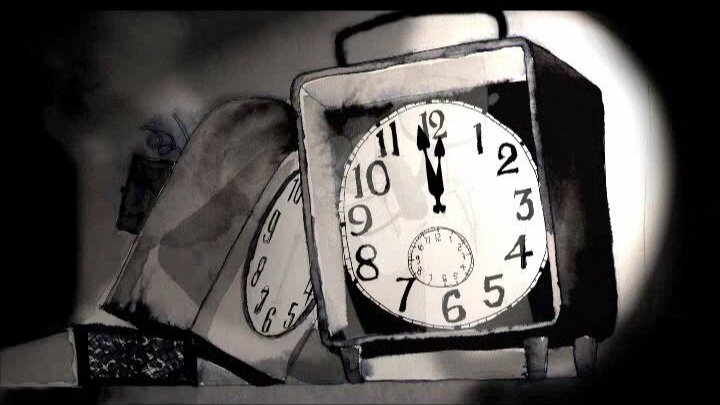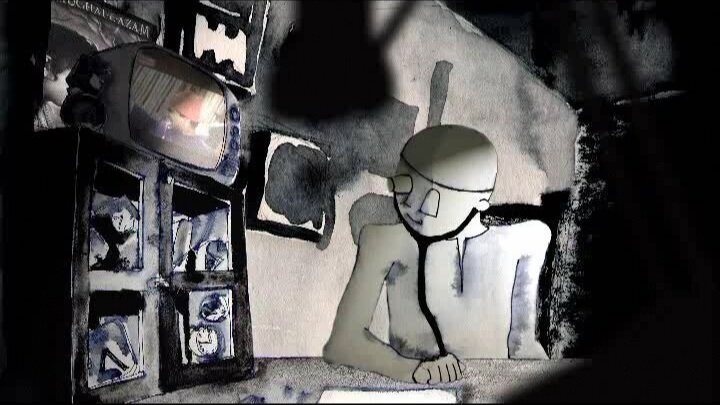Hua Noor is a fleeting glimpse of an old clock repairman’s life, as he looks back at his life one stormy night.
Hua Noor was my first student film made at the Srishti School of Art, Design and Technology in 2003.
STILLS
‘Mise en scene’ in Animation
An academic paper that compares my film ‘Hua Noor’ with ‘Les Triplettes des Belleville’ .
I wrote this paper while studying animation at the Emily Carr University in 2006.
In another example, when Madame Souza tries to help out and clean up the house where the old Triplettes live, they abruptly ask her not to. She is not allowed to clean the house with the vacuum cleaner, replace the uneaten food in the fridge or read the newspaper. This strikes us viewers as odd, and we are made to believe that the Triplettes are unusually queer in their habits. However, in an important Salon sequence that follows shortly after this they emerge on stage with these props, using them as improvised musical instruments. Thus the props in this film directly affect the plot and take it forward.
It is this type of storytelling that inspired me in 'Hua Noor'. It was my intention to convey vital information through physical/visual codes and create a strong environment and mood for the film. In my original script, there was to be no dialogue. However, due to a severe shortage of time and resources I had to re-edit my script and introduce a voice over to tie the story together. I see this as a severe compromise and can now (having gained a fair amount of objectivity from the film) analyze it critically.
In 'Hua Noor' what works well is the mood space in which the film is told. The objects that are there in the room all point a finger towards the intended assumption- that the old clock repairman is from a different generation from today. The poster on the wall is of the film 'Mughal-e-Azam', a landmark film in India as it was made in the 50's when colour film first came out there. The TV by the desk is the only link to the 'outside world' and is set on a Discovery Channel program about the Mughal Invasion in India. Later on, when the old man changes the channel, it switches to a modern day music video which starkly contrasts the content of the previous channel. This change is of great importance to the story as it signals the change in the ‘outside world’.
The mise en scene not only informs us about where the film is set, the time, social implications, but also sets an evocative mood and backdrop for the story. The clocks on the walls span several generations and quite literally point to the times that have passed.
Keeping 'Les Triplettes' as a reference, what works in ‘Hua Noor’ is the mise en scene. What doesn’t work in my film is the lack of closure in the story. It is my opinion that the film is too abstract and open ended, and leaves the viewer waiting for more. It was my intention to have an abrupt ending, but what emerges is a feeling of incompleteness. 'Les Triplettes' is an abstract and open film, yet all the threads and plot points tie up in the end together. The more one analyses the film, the more connections are made and things make more sense.
In stark contrast to these two films, is ‘Path to God’, a short Flash animation I did around the same time as ‘Hua Noor’. The film is set on one page of a comic book, and there are no pans or camera movements. The action moves from one frame of the comic to another as the film advances. The character is rendered simply and compliments the simple line drawing of the background. The story is simple- ‘Running after God is futile as you will find yourself in the same place as where you began’, and thus demands a simple mise en scene.
To conclude, mise en scene is critical to story telling and should be dictated by the need of the film. Every story has an intrinsic level of complexity inherent in it, and the decisions on how to best illustrate them will critically affect how the film is read. In Animation (as opposed to Live Action) mise en scene is of great importance as the world that is created does not exist, and the viewer sees only what is intentionally created.
I was a Graphic Designer until I saw 'Les Triplettes des Belleville' (2003) by Sylvain Chomet. Needless to say, the film affected me so much, that I decided to switch my major and devote myself to Animation. Only recently, having come to ECIAD have I been able to look at the film objectively, and not look at it as the ‘end-all’ of Animation. However, in this paper I will discuss the relevance of Mise en Scene (the process of setting a stage, with regard to placement of actors, scenery, properties, etc.), how it plays an important role in Animation story-telling, and how I have used these ideas and influences in my personal work.
I would like to compare 'Les Triplettes de Belleville' to 'Hua Noor' (The New Day) a film I made inspired by it. I will also touch upon another experimental film I did- ‘The Path to God’, and discuss the radically different mise en scene in the film, and how it is relevant to that form of storytelling.
'Les Triplettes' is unique in its style of story-telling in the current Animation world dominated by 3D production houses. It is an 80 minute film, created almost completely in 2D animation (a medium slowly becoming obsolete) with a few sections in 3D. The quaint and complex plot is divulged completely without dialogue, thus bringing the focus of the medium back onto strong animation that involves acting, evocative stagings and strong sound design. The film questions the usual audience of mainstream animation (which is now predominantly for children) and proposes a different 'world view' altogether than from what we see usually.
'Les Triplettes' revolves around Champion, a young quiet boy who is introduced to cycling by his over-protective grandmother Madame Souza in the rainy city of Paris. Champion grows into a dedicated cyclist (relentlessly trained by his grandmother) and enters the Tour de France. He is kidnapped by members of the French wine mafia and shipped to the mysterious city of Belleville to be a pawn in an intricate betting machine. Madame Souza and their dog Bruno travel across the ocean (on a heroic paddle boat voyage) in search of Champion, where they meet the old, haggard yet lively Triplettes from Belleville. Together, they rescue Champion from the 'bad guys' and head into the unknown future together.
'Hua Noor' (The New Day) is a fleeting glimpse of an old clock repairman's life as he looks back at the 'times' that have passed and wonders what the future holds for an old relic like him. The film is set in todays world, and tries to evoke the disparity that exists in our Modernity in India. He realizes that his ‘analog’ life will soon come to an end with the advent of new technologies and cultures, and thus render his obsolete.
In both films, what strikes me as vital in the storytelling style is the mise en scene. Both films use aspects of props, set design, lighting as an important storytelling tool to advance other cinematic aspects like acting, camera decisions etc… The mise en scene also goes hand-in-hand with the 'world view' that is proposed in the film and relates to the way 'reality' is addressed on-screen through architectural perspectives, lighting and character design. This form of ‘visualizing the world’ is strongly influenced by traditional lens based media like the 35mm camera. What results is a world not too far away from our own, and thus allows us to unknowingly enter into the frame of the film, and make the ‘make-believe’ animated world more believable.
In 'Les Triplettes' due to the absence of dialogue, all the script points where vital information is conveyed are expressed through mime and mise en scene. Everything is there for a reason, and ultimately helps in tying the plot together in the end. For example, Madame Souza is seen with a wooden platform beneath her feet, which is a result of the tilting of the house due to a newly constructed railway line which happens in the beginning of the plot. This detail seems rather unnecessary for most of the film. However, in the final chase sequence, she uses her wooden sole to 'trip' her adversaries once and for all.








